
Welcome back to the “How to” series on pitching, where we will be diving into various pitches and speak about different grips, cues, tips, movement profiles, and even a top MLB comparison for reference when looking at a given pitch. Next up, how to throw a 4-seam fastball.
Overview

The 4-seam fastball is typically the “staple” of a pitcher’s arsenal. From youth to professional athletes, pitchers at all levels commonly throw a 4-seam fastball. It is often the fastest pitch that a pitcher will throw. In addition, it will maintain a good amount of vertical break (VB) and slight amounts of horizonal break (HB). The more separation between the two, favoring the vertical break will be the most advantageous for this pitch. Obviously, the amount of break in the vertical and horizontal plane will be dependent on the arm slot.
Although we will dive into this topic more later on in the article, it is important to state that the most effective 4-seam fastballs maintain high degrees of induced VB which causes the pitch to “carry” or “jump” on the hitter more than they would expect it to. Higher degrees of induced VB can cause more swings and misses, fly outs, and pop ups compared to other pitches.
Desired Movement Profile
Before we talk about the tips and tricks on how to throw a better 4-seam fastball, let’s continue to discuss how we want this pitch to move. Typically, depending on the arm slot, we look for 15+ inches of VB on a 4-seam fastball. However, can ELITE 4-seam fastball will maintain 18 or more inches of VB. In addition, we typically look for <10 inches of HB with this pitch.
So what are some factors that can help you increase your VB on your 4-seam fastball?
-
- Changes to the spin axis
- Increased spin efficiency
By being aware of your spin axis when throwing the 4-seam fastball, it could allow you to get more “on top” of the baseball. Being more “on top” will allow you to increase the true backspin and overall spin efficiency of the pitch. These two metrics can both positively increase induced VB on your 4-seam fastball. By increasing induced VB on your 4-seam fastball, it could result in:
-
- Generate more swings and misses
- Generate more flyouts and pop ups
- Creating a “carry” or “jump” effect that can catch hitters off-guard
Ideal 4-seam Fastball Location on a Movement Chart
A movement chart is a tool that players and coaches can use to analyze the ideal movement and placement of a given pitch.
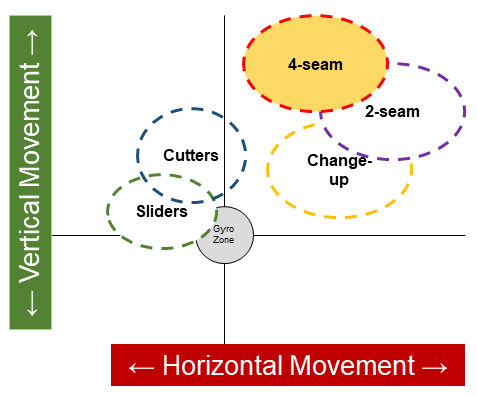
What each zone represents:
-
- The grey circle in the center of the chart represents the “gyro zone” which is no movement in either the vertical or horizontal plane
- The upper right quadrant represents positive vertical movement and positive horizontal movement
- The upper left-hand quadrant represents positive vertical movement and negative horizontal movement
- The lower right-hand quadrant represents negative vertical movement and positive horizontal movement
- The lower left-hand quadrant represents negative vertical movement and negative horizontal movement
The chart pictured above is representative of a right-handed pitcher’s ideal placement for each pitch. This puts the 4-seam fastball in the upper right-hand quadrant as the most ideal location for amount of movement. For lefties, the VB would stay the same. But the horizontal movement that would be desired would have negative value. Therefore, making the upper left-hand quadrant as the most ideal for a left-handed 4-seam fastball.
4-seam Fastball Grip
Now let’s dive into how to grip the 4-seam fastball. The grip for the 4-seam fastball is pretty standard:
-
- The index and middle finger will be placed on top of the baseball, with the fingertips slightly over the seams of the horseshoe
- The ring and pinky finger will be off to the side
- The thumb positioning will be flat or tucked – depending on preferred feel and how it influences induced VB
- Horseshoe will either be to the inside or outside – depending on preferred feel and how it influences induced VB
Below are several variations for the 4-seam fastball grip we use with our athletes:
Grip 1 – Horseshoe inside w/ flat thumb
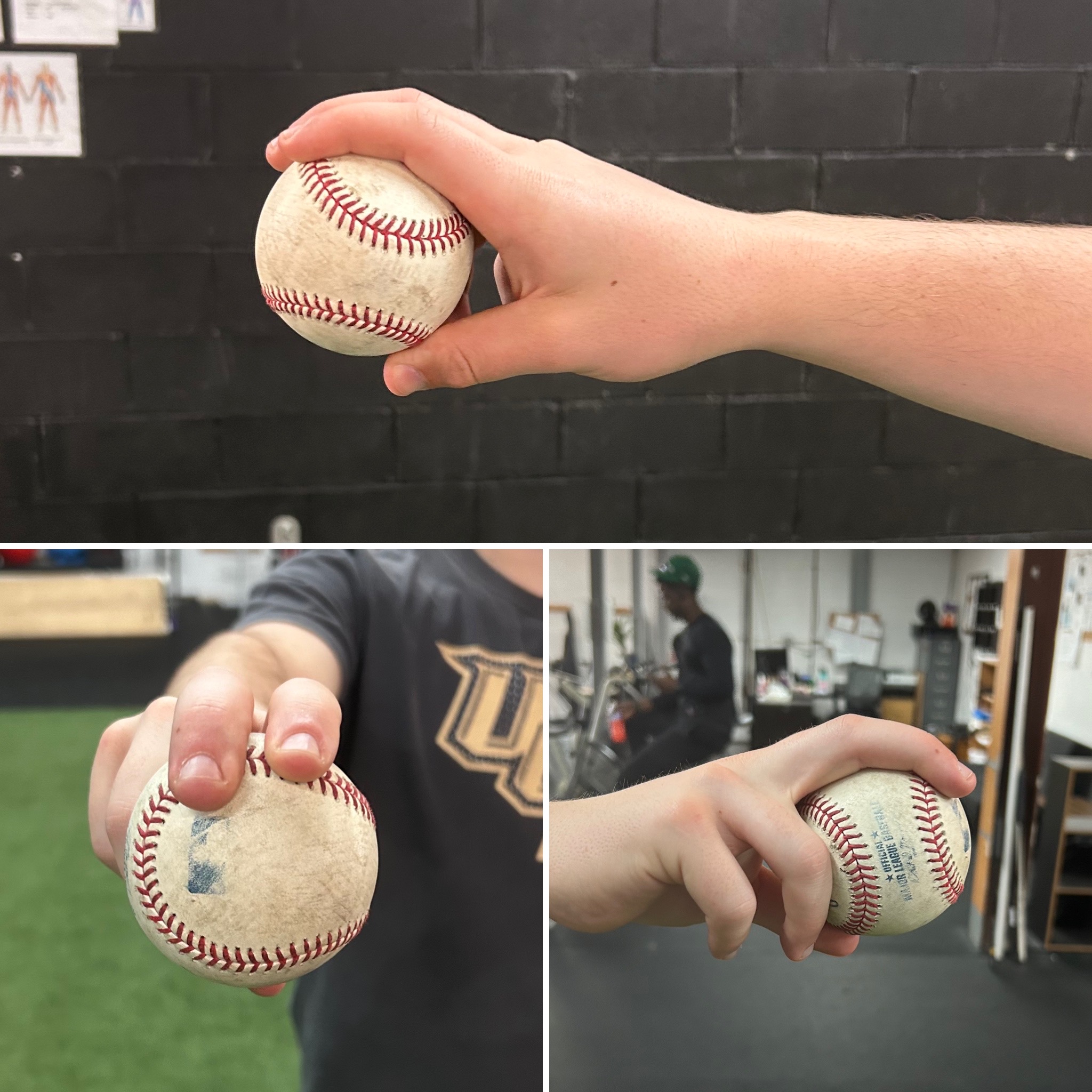
Grip 2- Horseshoe inside w/ tucked thumb
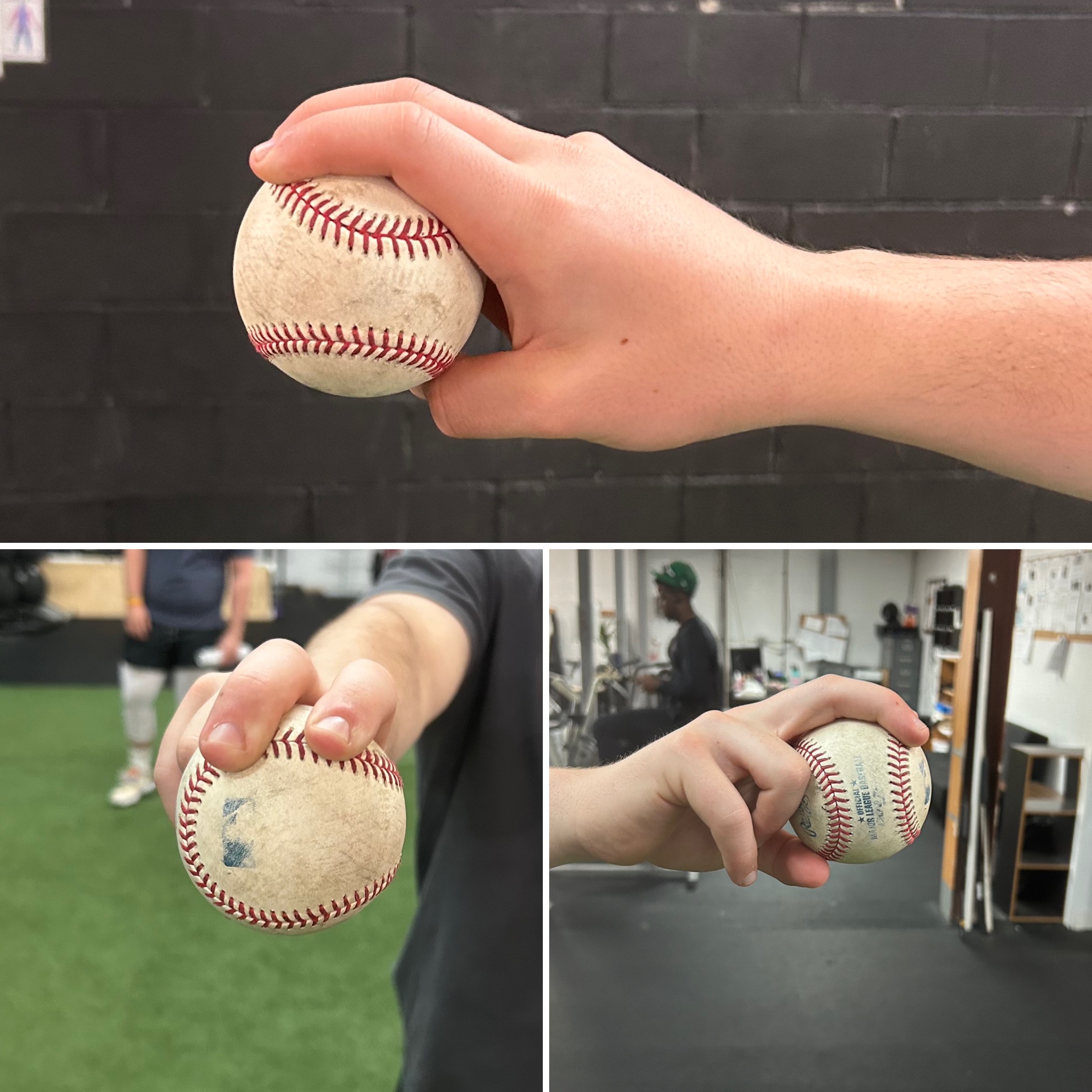
Grip 3- Horseshoe outside w/ flat thumb
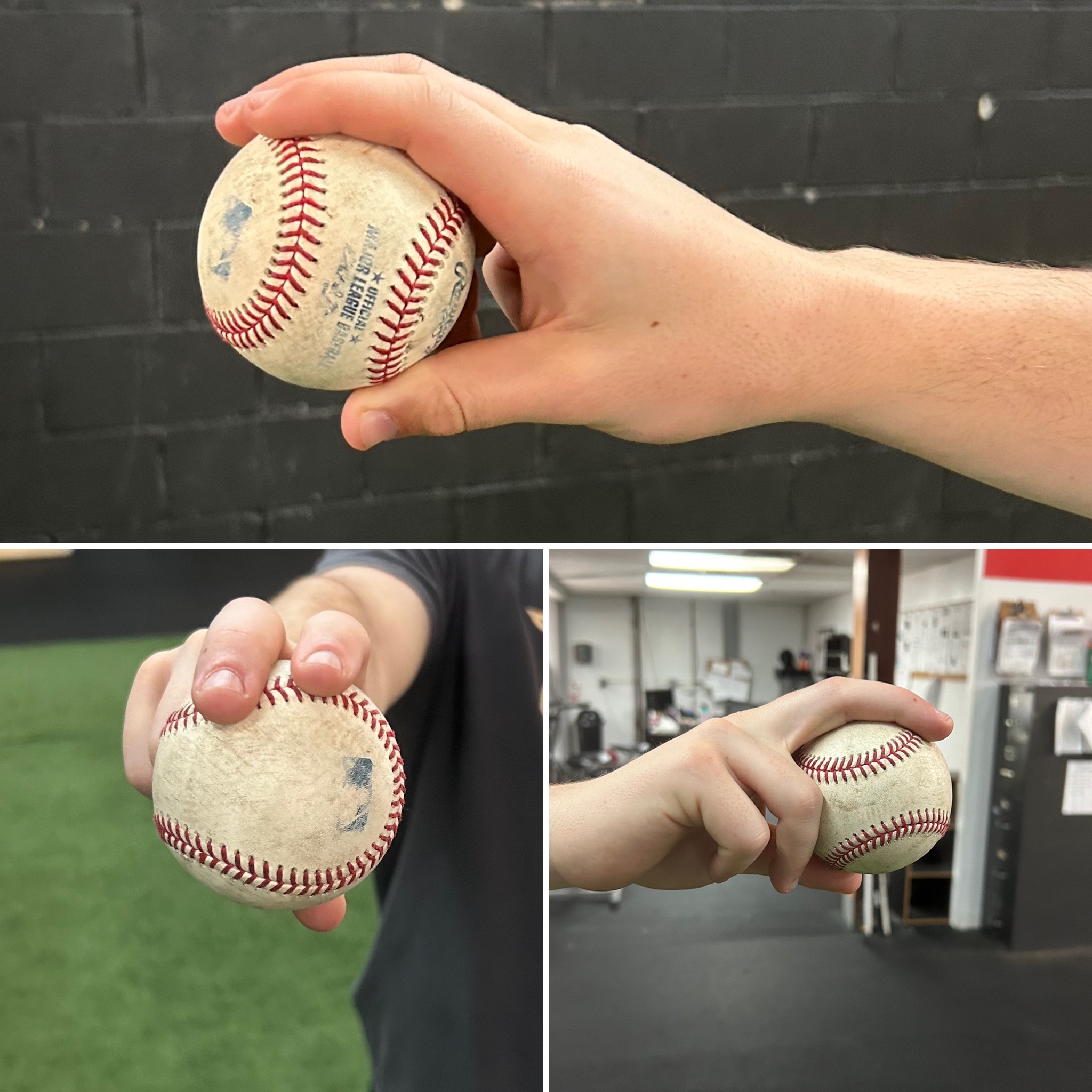
Grip 4- Horseshoe outside w/ tucked thumb
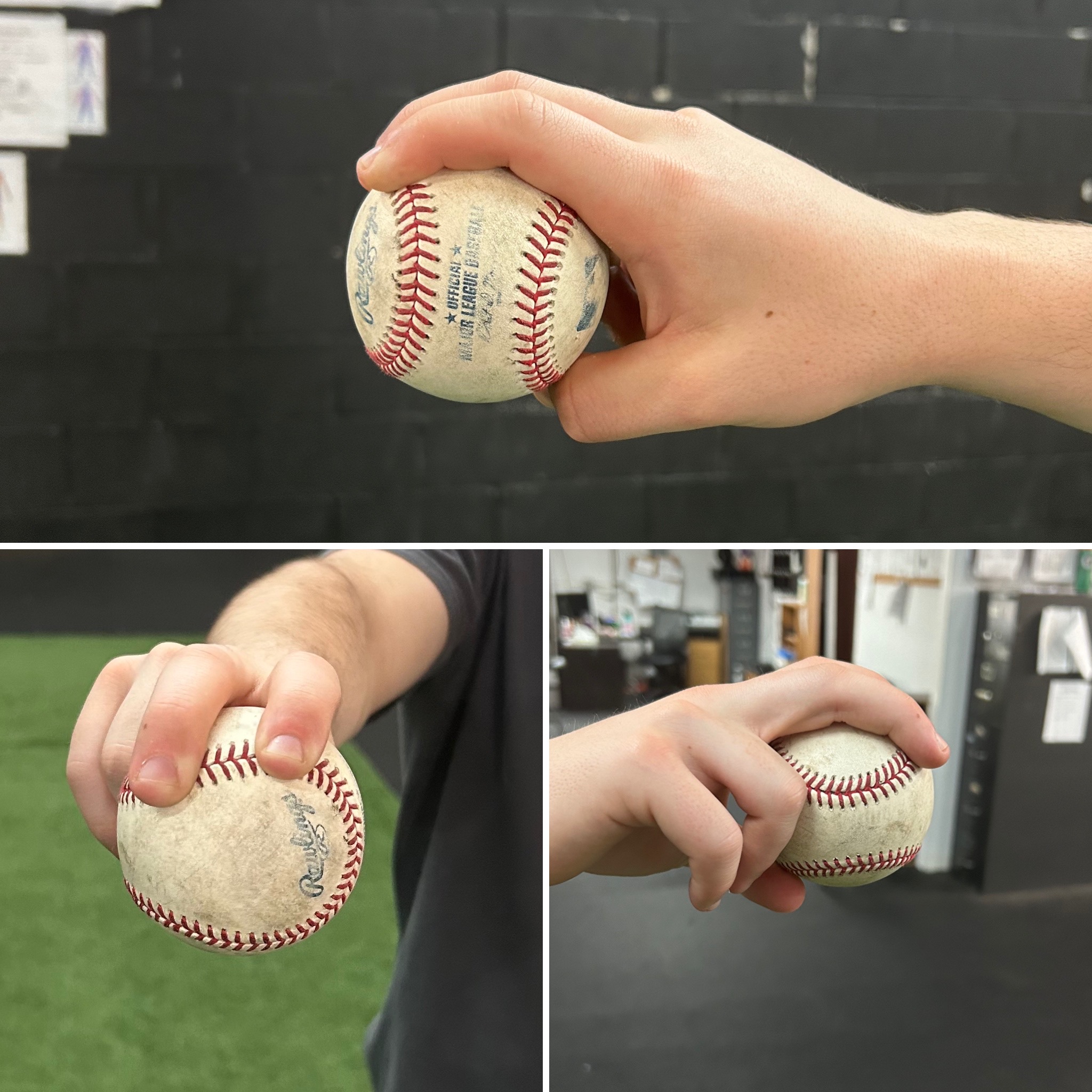
Cues to Help you Throw a 4-seam Fastball
Let’s start with this… throwing cues are NOT ONE SIZE FITS ALL!!
There are many different cues that people use when teaching pitchers how to throw each pitch. You need to find which cue best suits YOU and helps YOU throw your 4-seam fastball more effectively. Some of the cues we use with our athletes are:
-
- “Stay behind the ball”
- “Get on top of it”
- “Rip the seams straight down”
- “Set your sights high”

What we like to see:
-
- A spin efficiency of 90% or higher (the higher the spin efficiency the better)
- No specific spin axis (because pitchers use different arm slots)
- Relatively consistent spin axis
- Good command around the zone
- Hardest pitch in your arsenal
What we don’t like to see:
-
- Spin efficiency under 80%
- Getting the “cut action” or glove-side movement
- Somewhat inconsistent spin-axis
- Somewhat inconsistent spin-efficiency from pitch-to-pitch (the more inconsistent the spin-axis and spin-efficiency, the more inconsistent the break, implying less overall command of the pitch)
Tunneling tips and When, Where to Throw a 4-seam Fastball
Being a staple in a pitcher’s arsenal, it’s important to be able to effectively tunnel this pitch with the off-speed pitches in your arsenal and create deception against the hitter. The 4-seam fastball tunnels well off the following: Cutters, Curveballs, Gyro sliders, Dropping change-ups and Splitters.
All of these pitches operate in the vertical plane or have lesser vertical movement than the 4-seam fastball. Thus, they will tunnel well out of the pitcher’s release and eventually move in a different direction than the 4-seam fastball. This deception will allow the pitcher to disrupt the hitters timing at the plate.
Elite MLB 4-seam fastball
Carlos Rodon is a great example of someone who throws an ELITE 4-seam fastball. Last year, Rodon had one of the best 4-seam fastballs in all of baseball. Coming in at 95+ MPH with a ton of induced VB, Rodon used this elite pitch 61% of the time in 2022. Rodon’s 4-seam fastball produced a .213 BA, .284 wOBA, 27.9 whiff %, and 24.1 K %. He is a great example to look at when trying to emulate an ELITE 4-seam fastball.
By Jake Lebovitch (Pitching Coordinator, Strength Coach at RPP Baseball)
Articles in the How to Throw series:
You live too far to train with us in-house at RPP? You can now train with us on a REMOTE basis.


